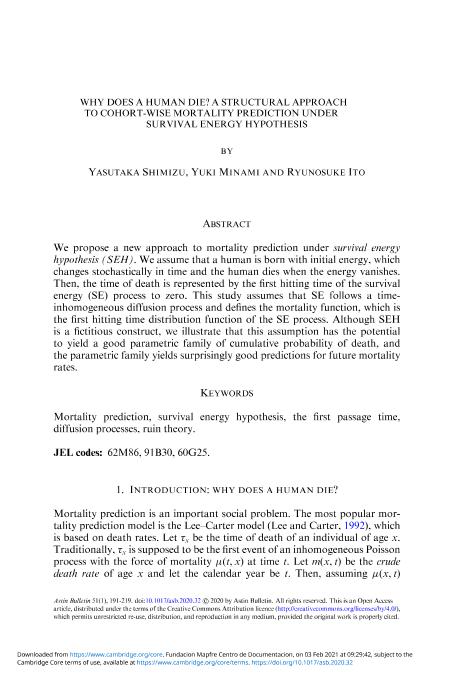Why does a human die? A structural approach to cohort-wise mortality prediction under survival energy hypothesis

Contenido multimedia no disponible por derechos de autor o por acceso restringido. Contacte con la institución para más información.
| Tag | 1 | 2 | Value |
|---|---|---|---|
| LDR | 00000cab a2200000 4500 | ||
| 001 | MAP20210005510 | ||
| 003 | MAP | ||
| 005 | 20210223091316.0 | ||
| 008 | 210218e20210101bel|||p |0|||b|eng d | ||
| 040 | $aMAP$bspa$dMAP | ||
| 084 | $a6 | ||
| 100 | $0MAPA20210003073$aShimizu, Yasutaka | ||
| 245 | 1 | 0 | $aWhy does a human die? A structural approach to cohort-wise mortality prediction under survival energy hypothesis$cYasutaka Shimizu, Yuki Minami, Ryunosuke Ito |
| 520 | $aWe propose a new approach to mortality prediction under survival energy hypothesis (SEH). We assume that a human is born with initial energy, which changes stochastically in time and the human dies when the energy vanishes. Then, the time of death is represented by the first hitting time of the survival energy (SE) process to zero. This study assumes that SE follows a timeinhomogeneous diffusion process and defines the mortality function, which is the first hitting time distribution function of the SE process. Although SEH is a fictitious construct, we illustrate that this assumption has the potential to yield a good parametric family of cumulative probability of death, and the parametric family yields surprisingly good predictions for future mortality rates. | ||
| 650 | 4 | $0MAPA20080555306$aMortalidad | |
| 650 | 4 | $0MAPA20080586447$aModelo estocástico | |
| 650 | 4 | $0MAPA20080579258$aCálculo actuarial | |
| 650 | 4 | $0MAPA20080588281$aTeoría de la ruina | |
| 700 | 1 | $0MAPA20210003080$aMinami, Yuki | |
| 700 | 1 | $0MAPA20210003097$aIto, Ryunosuke | |
| 773 | 0 | $wMAP20077000420$tAstin bulletin$dBelgium : ASTIN and AFIR Sections of the International Actuarial Association$x0515-0361$g01/01/2021 Volumen 51 Número 1 - enero 2021 , p. 191-219 |

